Links to blog posts Parts 1, 2 and 3. Youtube video summaries Parts 1, 2, 3 and 4.
All the glowing studio publicity pumped out for Moran of the Lady Letty as illustrated in the ad below had to meet the test when the reviewers saw the film. The reactions were mixed and theater owners reported much different levels of audience interest depending on where the film was shown.

Reviewers emphasized different aspects of the film such as the action and the appearance of the cast, with some being unimpressed and others being very favorable. Although most wrote straightforward reviews, there were some harsh, even caustic and sneering opinions aimed at the two leads.
Here are two examples of the first reviews after the premiere in New York City on February 5, 1922.

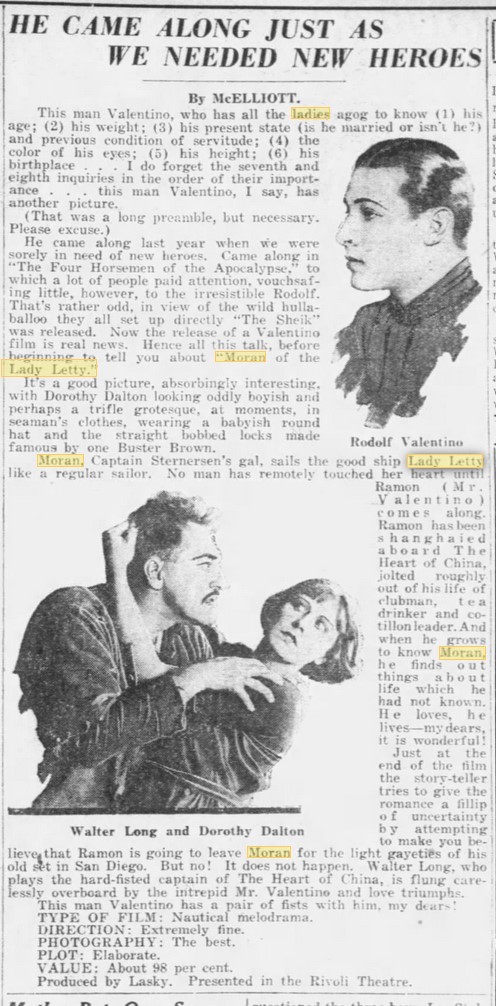
The reviewer from The New York Herald remarked that the plot line “strained credulity a bit when it came to a girl remaining alive all night ” after the ship’s fire that “killed strapping men.” But the critic thought Dorothy Dalton generally gave “a forceful characterization of the girl who wanted to be a man except when her hair gets into her performance.” This critic was fixated on the actors’ hair and overall appearance! “To bob or not to bob was evidently the burning question that faced Miss Dorothy Dalton in girding herself up for this picture.” The critic regretted that she “trimmed her hair to the length standardized for horses” and “it seems to hang in strings of licorice around her face. The ordinarily enchanting countenance of Miss Dalton becomes as broad beamed as a ship, and her charming smile turns into a hatchway.”
Valentino got off relatively easy with the comments that “as evidence that his rough experience before the mast works a transformation of character, he no longer wears the patent leather haircomb of his San Francisco trifling,” and how “one feels that even when…he is sloshing water from a bucket, …that he could change instantly into his best party manner and slosh tea from a cup.”
By contrast, the Daily News reviewer McElliot heralded Valentino as a much-needed new hero and considered the release of Moran of the Lady Letty as “real news.” He valued the film at about “98 per cent” and remarked that “This man Valentino has a pair of fists with him, my dears!” But Dalton came up short again as she looked “oddly boyish and perhaps a trifle grotesque, at moments, in seaman’s clothes…and the straight bobbed locks made famous by one Buster Brown.” (See NOTES below for more information about Buster Brown and my own Buster Brown haircut and shoes!)

“strings of licorice around her face”–New York Herald review

“…bobbed locks made famous by one Buster Brown”–McElliot
A couple of days before the Los Angeles premiere (February 12, 1922) a syndicated review by James W. Dean, datelined New York, began appearing in newspapers. It started off with a dig at Valentino:
"It had to happen sooner or later, Francis X. Bushman used to get away with it with considerable regularity. Wally Reid has been guilty of it several times. Yessir, Rudolph Rodolf Rudolpho Rodolfo Whathis name Valentino just had to peel of his shirt off and get out in front of the Kliegl lights sooner or later in his sleeveless undershirt so the flappers might gaze upon his manly muscle."

Friday, February 10, 1922. Page 14.

Saturday, February 11, 1922. Page 10.
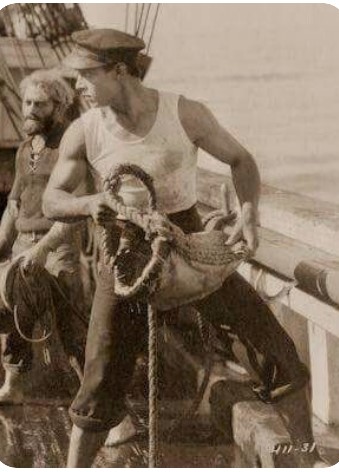
Then Dean moved onto Dorothy Dalton and her hair “shorn to within eight inches of her scalp” but finished his summary by praising director George Melford for not dressing Dorothy “up in evening low-cuts” and allowing her “to go right through the fade-out in her raggedy outfit without a wave or a ribbon in her hair. ” Ultimately, Dean praised both Valentino and Dalton for their work–in his opinion, Dalton’s “best film in months” and Valentino’s “better work in it than he has in any picture since ‘The Four Horsemen.'”
A couple of weeks later, a review in The St. Louis Dispatch (Monday, February 27, 1922, Page 17) had the exact opposite reaction to the actors’ work:
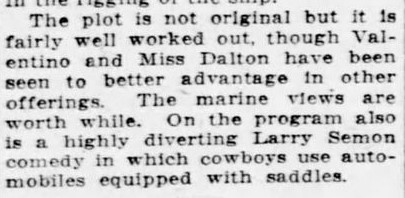
…Valentino and Miss Dalton have been seen to better advantage in other offerings.”
The St. Louis Dispatch, St. Louis, Missouri. Monday, February 27, 1922. Page 17.
As the film rolled out , reviews swung between either praising, disliking or ignoring Dalton and her hair and, with regard to Valentino, comparing him to his recent roles or praising him for his fighting skills.
The critic for The New York Herald had questioned the believability of the plotline because Dalton’s character survived a fire when “strapping men” did not (see review above) and The Baltimore Sun review also found fault with the story, failing to find the film a “convincing piece of drama.” But while The New York Herald critic at least credited Dalton with a “forceful characterization,” The Baltimore Sun showed no mercy toward Dalton calling her “well-nigh hopeless ” while passing off Valentino’s performance as “lacking.”
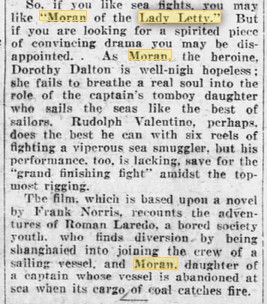
“…she fails to breathe a real soul into the role of the captain’s tomboy daughter….Rudolph Valentino, perhaps, does the best he can with six reels of fighting a viperous sea smuggler, but his performance, too, is lacking, save for the “grand finishing fight” amidst the top-most rigging.”
The Baltimore Sun, Baltimore, Maryland.
Tuesday, February 21, 1922. Page 5.
This idea that the plot was not up to par was often mentioned. A paper in Tacoma, Washington called the film “a fanciful story that pleases those who like Valentino’s style and Dorothy Dalton’s masculinity” (The News Tribune, Tacoma Washington, Monday, May 8, 1922. Page 8).
The April 1922 edition of Photoplay went so far as to call the picture “more or less pure hoakum that you’re almost ashamed of yourself for enjoying (Page 62). Whether it was because of “two sparklers such as Valentino and Dorothy Dalton…or the original power of the Frank Norris novel,” the writer could not really pinpoint what made the film enjoyable.

…but it’s good strong entertainment. Sea stuff; fights; love. Rodolph as usual; Dorothy with bobbed hair–yum yum! You’re bound to like it.”
Photoplay, April 1922. Page 62
Photoplay wasn’t the only publication that viewed the pairing of Dalton and Valentino in a positive light. A paper in Delaware described the pairing as “well nigh unbeatable in screen circles. The cream of beauty to both the feminine and masculine sense and the best screen ability are found in the two” (Every Evening, Wilmington Daily Commercial , Wilmington, Delaware, Saturday, April 15, 1922. Page 11). It’s interesting to note that the term “beauty” was already being applied to Valentino.
The Leader-Post in Regina, Saskachewan, Canada further elevated both Dorothy Dalton and Valentino.
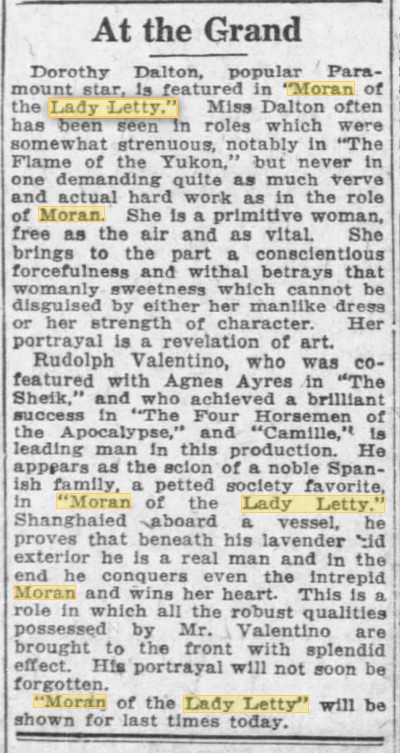
“…She brings to the part a conscientious forcefulness and withal betrays that womanly sweetness which cannot be disguised by either her manlike dress or her strength of character. Her portrayal is a revelation of art…
Rudolph Valentino…as a petted society favorite…proves that beneath his lavender kid exterior he is a real man and in the end he conquers even the intrepid Moran….This is a role in which all the robust qualities possessed by Mr. Valentino are brought to the front with splendid effect. His portrayal will not be soon forgotten.“
The Leader-Post, Regina, Saskatchewan, Canada. Saturday, May 13, 1922. Page 19.
Earlier in the film’s run Dorothy Dalton and Valentino received some kind words in The News-Post in Regina, Saskatchewan, Canada (Friday, March 17, 1922, Page 12). They describe how Dalton was “excellent’ in her role” while “Mr. Valentino gave a powerful portrayal as Ramon.” In this particular piece, the rest of the cast also received a nod: “The support generally as of the best.”
That “support” was mentioned in passing in many theater announcements and reviews. Walter Long wasn’t named specifically but his acting was mentioned in joint praise along with Valentino, when both were described as “great actors” in The Central New Jersey Home News, New Brunswick, New Jersey.

New Brunswick, New Jersey.

And, in what was an overall favorable review, Exhibitors Herald made a point of praising Walter Long right from the start: “Rudolf Valentino and Walter Long press the star (Dorothy Dalton) for honors.” The preview for the film’s opening at the Majestic Theatre in Shreveport, Louisiana quoted another publication, Exhibitor’s Trade Review, and also noted the performance of Walter Long. (Note: This publication should not be confused with Exhibitors Herald; unfortunately, the issue of Exhibitor’s Trade Review from February 1922, which would have included the review, is missing from the collection available at Archive.org).
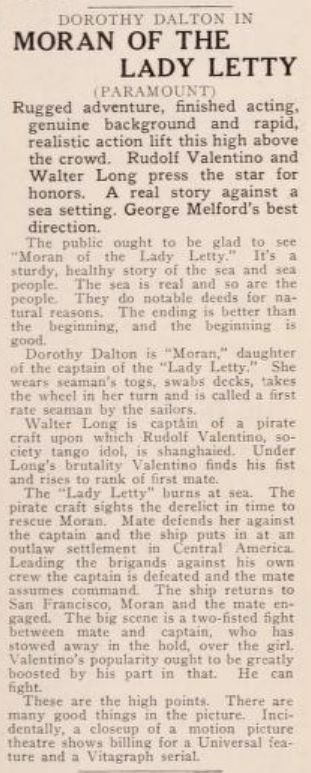

The review in the Exhibitors Herald concluded that “Valentino’s popularity ought to be greatly boosted by his part in that [the fight scene with Kitchell]. He can fight.”
The review in the trade publication Variety called Dalton “a new type of heroine”–“The sinuous frocks are gone. So are the vampish headresses….It’s an astonishing transfiguration from the typical Dalton roles.” But the reviewer also stated that “whether the fans will accept Miss Dalton in an ingenue part of this kind is an interesting consideration” because the character of Moran was rather a “colorless person” in translation to the screen.” The review went on to say that the real star of the picture was Valentino and noted that, like Dalton’s changed image, the change in the Valentino persona as a “fighter” was also a big shift in style and maybe even “a shock.”

As a rough-and-tumble fighting hero Valentino is a revelation…Physically he looks the part, but it comes as something of a shock, probably because he has so long been identified with roles of a daintier kind.
Variety, Friday, February 10, 1922. Page 34.
Exhibitor’s Herald featured a section called “Voice of the Box Office” which presented reports from the field about how pictures fared in various cities. These reports gave details on how a film was performing in terms of drawing an audience, other parts of the program, and the type of publicity the theater may or may not have used, such as billboards, lobby displays, newspapers, etc. Below is a sampling of reports from theater managers on how the film was being received. During the run of Moran of the Lady Letty, Valentino’s earlier films were still in circulation including his hit films, The Sheik and The Four Horseman of the Apocalypse, so it is interesting to see how they were still pulling in audiences even as Moran of the Lady Letty was playing during it’s initial run.

Note: Grauman’s Rialto was located in Los Angeles, California



A comment in an Ohio newspaper revealed a potential problem with Exhibitor’s Herald‘s conclusion that Valentino’s ability to fight would boost his popularity. While commenting that Valentino “proves he can ride the bounding main as gracefully as he does the camel,” the public was warned that they wouldn’t be seeing a sheik.

“Anybody who expects to see Rudolph Valentino syndicate the Sheik in ‘Moran of the Lady Letty,’…is doomed to heart-breaking disappointment. There is not a tent, a turban or a turbulent lover visible, even in the silhouette.”
The News-Journal, Mansfield, Ohio. Monday, March 6, 1922. Page 6.
And, apparently, some of the women fans, were not enthralled by what Variety had called the “shock” of the physical change in Valentino and the disappearance of the sheik character. Below is an interesting juxtaposition between the interest in Valentino’s sea-faring film playing in Omaha, Nebraska compared to that of the The Sheik, which was playing in Evanston, Illinois as the same time. While The Sheik had been re-booked for a third run in Evanston, Illinois and was turning away crowds, the theater management in Omaha, Nebraska reported that Moran of the Lady Letty started off well enough during the first half of the week, but Valentino as Ramon Laredo was missing the mark with the female audience!
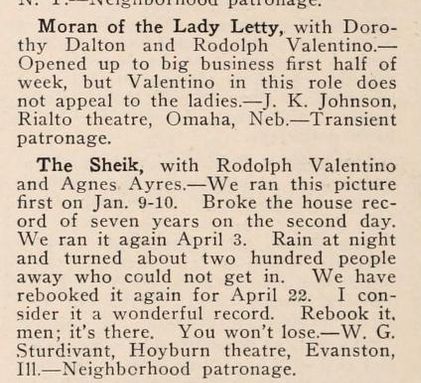
Exhibitor’s Herald, April 29, 1922.
Moran of the Lady Letty….”Rudolph Valentino in this role does not appeal to the ladies.” –Rialto Theatre, Omaha, Nebraska.
The Sheik…”Rebook it, men; it’s there. You won’t lose.”—Hoyburn Theatre, Evanston, Illinois.
Columnist Harry Carr, in his column “From a Carr Window” which appeared in the Los Angeles Times on Sunday, March 12, 1922 (Page 33), reviewed Moran of the Lady Letty within the broader context of the state of the movie industry, specifically noting the “tragic famine in stories.” In particular, he was exasperated by the proliferation of “business stories”–stories which centered on young wives neglected as their husbands focused on work. Calling these themes “absolutely unnatural,” Carr recites all the activities a wife would be involved in with “plenty to occupy her mind without waiting for her husband’s footsteps on the front stairs.” Ironically, in his opinion, most of this “sentimental slush” was churned out mostly by “women writers who know better.”

“Honestly, I couldn’t stand another one.”–Harry Carr
Los Angeles Times, Sunday, March 12, 1922. Page 33.
Carr wasn’t any happier about Moran of the Lady Letty, which he thought missed the mark in terms of direction and story. He pointed out that the audience had to get over “the sea atmosphere” to get to the story, but “the director did not get over the atmosphere.” And, overall, the character of the girl raised on a boat was not believable, a problem which was picked up by other critics as cited earlier in this piece.

“You never really believed that girl was living on a boat. There were no intimate little touches that made you feel it was really her home. Furthermore, you never believed that she knew how to steer or sail the ship.”
“…When she went to the wheel she spun the spokes around a lot, but you never believed for an instant she was really controlling the ship.”
“These points lacking–the big thrill that she got out of the battle with the cruel, relentless old ocean–you couldn’t get much interest or sympathy out of her reluctance to give up her sea-dog life to become the wife of a man.”
Los Angeles Times, Sunday, March 12, 1922. Page 33.
Carr concluded that “The point of the story seemed to me absolutely to depend upon getting over to the audience the idea that her ship absolutely filled this girl’s life.” And Carr obviously felt the film failed in conveying this key element.

“But,” he said yesterday, adjusting his gorgeous bullfighter costume. “You can always find consolation in everything. That picture gave me at least an opportunity, after so many lounge lizard parts, to show that I could be a fighting athlete.”–Rudolph Valentino
Los Angeles Times, Sunday, March 12, 1922. Page 33.
Carr apparently met Valentino on the set of Blood and Sand, which was already in production when Carr’s piece came out in March. And, according to his report, Valentino was not thrilled with Moran of the Lady Letty, either. Carr described Valentino as being a “weary traveler who has at last arrived at an oasis” by being given the lead role in what looked like a “good one in “Blood and Sand.” After telling Carr that he hated “The Sheik” Valentino found some consolation in his role in Moran of the Lady Letty because he wasn’t a lounge lizard and he could look like a “fighting athlete.”
For all the mixed reviews and the back and forth over which actor was the star of the film, there is no question that the momentum with the public was with Rudolph Valentino as Moran of the Lady Letty was released. In fact, even BEFORE the official premieres of the film in New York (February 5, 1922) and Los Angeles (February 12, 1922), movie goers in Stockton, California had an early opportunity to see the film and the publicity was skewed toward featuring Valentino. In fact, in the “review” touting “Valentino’s Magic,” the person responsible for using the studio publicity in The Stockton Evening and Sunday Record seemed to think that the film was already “bringing in crowds from all over Stockton, and the country as well” even before it went into wide release!

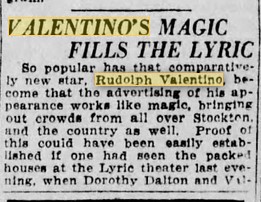
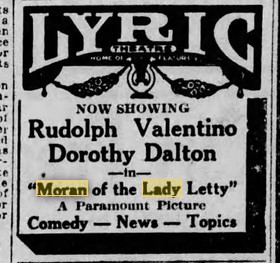
After the film opened in New York on Sunday, February 5, Variety reported in its February 10th edition what was obvious–Valentino was the draw on Broadway and Dorothy Dalton hadn’t even been mentioned in the advance billing.

Of course, Dalton would get her due in many venues as the film rolled out around the country because she was a popular player, but without a doubt Rudolph Valentino was definitely starting off his busy year of 1922 in “stellar fashion”….
NOTES
1. Full pages were often devoted to the showing of the film as it opened around the country. The large ad at the top of this post is taken from the full-page publicity push in The Fort Wayne Journal-Gazette, Fort Wayne, Indiana. Sunday, March 26, 1922. Section 4, Page 6.

2. Buster Brown–The Buster Brown comic strip originated in 1902 and in 1904, the character became licensed to the Brown Shoe Company. Buster Brown, whose name was inspired by the young vaudeville performer Buster Keaton, was a child of wealthy parents who was a prankster… as described at TVTropes.org, Buster Brown was essentially an Edwardian “Dennis the Menace” whose dog Tige, believed to be the first talking pet in a comic, would warn his master of the trouble he would create, but his warnings were usually unheeded and Buster would be spanked although it wasn’t clear if he really repented for actions. For more information, this piece at NPR is includes audio, a photo gallery, and links to many sources. One interesting bit of information details the use of midgets and small boys circa 1908 to dress up as Buster Brown to promote the sale of Buster Brown shoes.


Years later I would love my Buster Brow saddle shoes!
(Left) On a personal note, here is a picture of me with my Buster Brown shoes from 1956! (Below) My full-blown Buster Brown hairdo in 1954.

3. Exhibitors Herald originated in 1915 as a regional trade paper for exhibitors of films. Through mergers, it developed into a national publication for the film industry. Source: Wikiwand, “Motion Picture Herald” entry.
SOURCES
Newspapers and periodicals as cited in the text
NPR (National Public Radio). Present at the Creation: Buster Brown. Includes links to the Buster Brown series of silent movies made by Thomas Edison and other material at the Library of Congress. Direct link to the Buster Brown materials at the Library of Congress.
TVTropes.org. Comic strip/Buster Brown entry.
SOURCES as

Great blog! Although ‘MOTLL’ was not my favorite Rudy-movie, I really like the way you gave us all the information! I, too, run a blog (under a different hosting site) and I know the amount of work we put in for these blogs. It is NOT as easy as it looks … in fact, the easier it looks, the harder we have worked to make it look easy. If that makes any sense … keep up the fantastic work. There is quite an interesting history of Rudy and the San Francisco area and his hijinks he got up to while he was filming this movie there.
LikeLike
Thanks for you kind comment! I try to be meticulous in my research and tell a story, and sometimes correct false ideas about Valentino when I see discrepancies in the lore versus what the deeper research and looking at the source material again. I’m hoping to finally get my computer issues finally solved, as my old one was trashed and I will be getting a replacement from Best Buy! FINALLY! Thanks again for your comment!!!
LikeLiked by 1 person